Western European theatre
Normandy
Commanded by General (later Field Marshal) Sir Bernard Montgomery, 21st Army Group initially controlled all ground forces in Operation Overlord (the United States First Army and British Second Army). When sufficient American forces had landed, their own 12th Army Group was activated, under General Omar Bradley, and the 21st Army Group was left with the British Second Army and the newly activated First Canadian Army which, despite its title, also contained many British and Polish troops. [2]
Normandy was a battle of attrition for the British and Canadian troops, drawing in most of the available German reinforcements, especially armoured divisions, around Caen at the eastern end of the lodgement. These operations left the Germans unable to prevent the American breakout at the western end of the Normandy beachhead in early August 1944. Following the German attack towards Mortain, the American breakout and an advance by the 21st Army Group the German armed forces in Normandy were nearly enveloped in the Falaise pocket, and subsequently routed, retreating towards the Low Countries. [3]
Advance into the Low Countries
After the successful landings in the south of France by the US 6th Army Group, the 21st Army Group formed the left flank of the three Allied army groups arrayed against German forces in the West. It was therefore responsible for securing the ports upon which Allied supply depended, and also with overrunning German V-1 and V-2 launching sites along the coasts of western France and Belgium. [4]
By 29 August, the Germans had largely withdrawn across the Seine River without their heavy equipment. The campaign through Northern France and Belgium was largely a pursuit, with the ports - formally designated "Fortress Towns" by the Germans - offering only limited opposition to the First Canadian Army. The advance was so rapid, 250 miles in four days, that Antwerp, Belgium, was captured undefended on 4 September 1944 and the port facilities were cleared of the German defenders in the following days. [5]
On 1 September 1944, the 21st Army Group was relieved of operational control of the American armies, and those armies formed the 12th Army Group. [6]
By mid-September, elements of 21st Army Group had reached the Dutch border, but were halted due to lack of supplies, and by flooding caused by the widespread German demolition of Dutch dikes. German control of some of the channel ports and the approaches to Antwerp, and previous Allied bombing of the French and Belgian railways, resulted in a long supply line from Normandy served mainly by trucks. [7]
Operation Market Garden
After the break-out from Normandy, there were high hopes that the war could be ended in 1944. In order to do so, the last great natural defensive barrier of Germany in the west, the Rhine River had to be crossed. Operation Market Garden was orchestrated to attempt just this. It was staged in the Netherlands with the airborne troops of the American 82nd and 101st and one British 1st airborne divisions and the 1st Polish Parachute Brigade (attached to the 1st Airborne Division) being dropped to capture bridges over the lower Rhine before they could be blown by the Germans. The airborne formations were then to be relieved by armoured forces of the Guards Armoured Division advancing rapidly northwards through Eindhoven and Nijmegen to Arnhem, opening the north German plains, and the industrial Ruhr Valley, to the Allies. [7]
However, the British armoured forces had only one main highway to operate on, and crucial information about the German forces in the operational area was either missing or ignored. The scratch forces remaining after the retreat from France were much stronger than expected, thus giving the armoured units of the XXX Corps a much tougher fight than had been anticipated, slowing the advance. The 1st British Airborne Division in Arnhem was practically destroyed during the battle. [8]
The advance stopped south of the Lower Rhine, resulting in a narrow salient that ran from the north of Belgium across the south-east of the Netherlands and was vulnerable to attack. German assaults in this salient, particularly north of Nijmegen were repelled. [9]
The thin salient was then expanded Eastwards with Operation Aintree which saw bitter fighting around the town of Overloon. To the West Operation Pheasant was conducted which resulted in the liberation of the cities of Tilburg and 's-Hertogenbosch broadening the front line. [10]
Battle of the Scheldt
Since the approaches to the port of Antwerp had not been cleared when the city was captured it had allowed the German army time to reorganise and dig in along the approaches making the port completely unusable. Thus an operation was needed to clear the approaches and thereby ease the supply problem. The island of Walcheren was strongly held by German forces and commanded the estuary of the Scheldt which flows through Antwerp. Operations by II Canadian Corps cleared the approaches to Antwerp both north and south of the water during the Battle of the Scheldt. Walcheren itself was captured in late 1944 by the last major amphibious assault in Europe in the Second World War. A combination of British and Canadian forces and Royal Marines undertook the operation. [11]
Battle of the Bulge
After the capture of Walcheren came the last great German offensive of the war in the west. In a repeat of their 1940 attack, German formations smashed through weak Allied lines in the Ardennes in Belgium. The Battle of the Bulge presented a command problem to General Eisenhower. It had sliced through US lines, leaving some American formations north and south of the new German salient. However, the headquarters of the US 12th Army Group lay to the south, and so Eisenhower decided to place American forces north of the "Bulge" salient under 21st Army Group. They, with the US Third Army under General George S. Patton, reduced the salient. [12]
After the battle, control of the First US Army which had been placed under Field Marshal Montgomery's temporary command was returned to Bradley's 12th Army Group. The US Ninth Army remained under Montgomery longer, before being returned to American command in Germany. [13]
Battle for the Roer Triangle
Prior to the Rhineland Campaign the enemy had to be cleared from the Roer Triangle during Operation Blackcock. This large methodical mopping up operation took place between 14 and 27 January 1945. It was not planned to make any deep thrust into the enemy defences or capture large numbers of prisoners. It proceeded from stage to stage almost entirely as planned and was completed with minimal casualties. [14]
Rhineland Campaign
Allied forces closed up to the Rhine by March 1945. [15] 21st Army Group at this time comprised the British Second Army under General Miles Dempsey, the First Canadian Army under General Harry Crerar and the US Ninth Army, under General William Simpson. [16]
The First Canadian Army executed Operation Veritable in difficult conditions from Nijmegen eastwards through the Reichswald Forest then southwards. [17] This was to have been the northern part of a pincer movement with the US Ninth Army moving northwards towards Düsseldorf and Krefeld (Operation Grenade), to clear the west bank of the Rhine north of Cologne. However the Americans were delayed by two weeks when the Germans destroyed the Roer dams and flooded the American route of advance. As a result, the Canadians engaged and mauled the German reserves intended to defend the Cologne Plain. [18]
In Operation Plunder, starting on 13 March 1945, the British Second Army and the US Ninth Army crossed the Rhine at various places north of the Ruhr and German resistance in the west quickly crumbled. The First Canadian Army wheeled left and liberated the northern part of the Netherlands and captured adjoining areas of Germany, the British Second Army occupied much of north-west Germany [19] and the US Ninth Army formed the northern arm of the envelopment of German forces in the Ruhr Pocket and on 4 April reverted to Omar Bradley's 12th Army Group. [13]
On 4 May 1945, Field Marshal Montgomery accepted the unconditional surrender of the German forces in the Netherlands, in north west Germany and Denmark. [20]

Field Marshal Bernard Law Montgomery, 1st Viscount Montgomery of Alamein,, nicknamed "Monty", was a senior British Army officer who served in the First World War, the Irish War of Independence and the Second World War.

Operation Market Garden was an Allied military operation during the Second World War fought in the German-occupied Netherlands from 17 to 25 September 1944. Its objective was to create a 64 mi (103 km) salient into German territory with a bridgehead over the Nederrijn, creating an Allied invasion route into northern Germany. This was to be achieved by two sub-operations: seizing nine bridges with combined US and British airborne forces ("Market") followed by British land forces swiftly following over the bridges ("Garden").

I Corps was an army corps in existence as an active formation in the British Army for most of the 80 years from its creation in the First World War until the end of the Cold War, longer than any other corps. It had a short-lived precursor during the Waterloo Campaign. It served as the operational component of the British Army of the Rhine during the Cold War, and was tasked with defending West Germany.
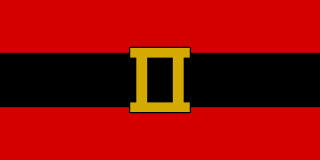
The British Second Army was a field army active during the First and Second World Wars. During the First World War the army was active on the Western Front throughout most of the war and later active in Italy. During the Second World War the army was the main British contribution to the Normandy landings on 6 June 1944 and advance across Europe.

The 17th Airborne Division, "The Golden Talons", was an airborne infantry division of the United States Army during World War II, commanded by Major General William M. Miley.
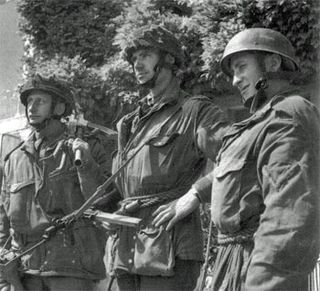
The 6th Airborne Division was an airborne infantry division of the British Army during the Second World War. Despite its name, the 6th was actually the second of two airborne divisions raised by the British Army during the war, the other being the 1st Airborne Division. The 6th Airborne Division was formed in the Second World War, in mid-1943, and was commanded by Major-General Richard N. Gale. The division consisted of the 3rd and 5th Parachute Brigades along with the 6th Airlanding Brigade and supporting units.

XXX Corps was a corps of the British Army during the Second World War. The corps was formed in the Western Desert in September 1941. It provided extensive service in the North African Campaign and many of its units were in action at the Second Battle of El Alamein in late 1942. It then took part in the Tunisia Campaign and formed the left flank during the Allied invasion of Sicily in 1943.
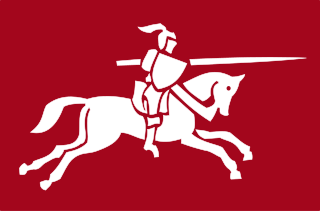
VIII Corps was a British Army corps formation that existed during the First and Second World Wars. In the latter, it took part in the Normandy Campaign in 1944, where it was involved in Operation Epsom and Operation Goodwood. It would later play a supporting role in Operation Market Garden and finish the war by advancing from the Rhine to the Baltic Sea.
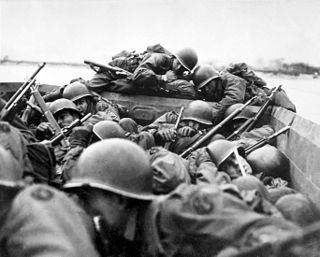
Operation Plunder was a military operation to cross the Rhine on the night of 23 March 1945, launched by the 21st Army Group under Field Marshal Bernard Montgomery. The crossing of the river was at Rees, Wesel, and south of the river Lippe by the British Second Army under Lieutenant General Miles Dempsey, and the United States Ninth Army under Lieutenant General William H. Simpson. The battle of the Rhine was crucial for the advancement of Allied forces.

The Siegfried Line campaign was a phase in the Western European campaign of World War II, which involved actions near the German defensive Siegfried Line.
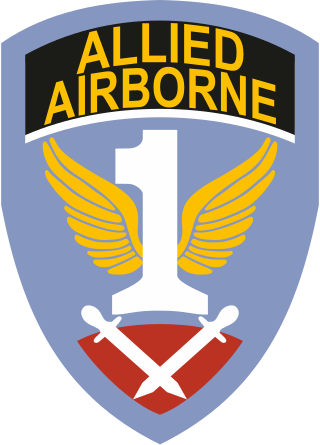
The First Allied Airborne Army was an Allied formation formed on 2 August 1944 by the order of General Dwight D. Eisenhower, the Supreme Allied Commander of the Allied Expeditionary Force.

Operation Veritable was the northern part of an Allied pincer movement that took place between 8 February and 11 March 1945 during the final stages of the Second World War. The operation was conducted by Field Marshal Bernard Montgomery's Anglo-Canadian 21st Army Group, primarily consisting of the First Canadian Army under Lieutenant-General Harry Crerar and the British XXX Corps under Lieutenant-general Brian Horrocks.

Operation Bluecoat was a British offensive in the Battle of Normandy, from 30 July until 7 August 1944, during the Second World War. The geographical objectives of the attack, undertaken by VIII Corps and XXX Corps of the British Second Army, were to secure the road junction of Vire and the high ground of Mont Pinçon.

The Battle of Overloon was fought in the Second World War between Allied forces and the German Army which took place in and around the village of Overloon in the south-east of the Netherlands between 30 September and 18 October 1944. The battle was an Allied victory, after the Allies launched Operation Aintree. The Allies went on to liberate the town of Venray.

II Canadian Corps was a corps-level formation that, along with I (British) Corps and I Canadian Corps, comprised the First Canadian Army in Northwest Europe during World War II.

At the start of 1939, the British Army was, as it traditionally always had been, a small volunteer professional army. At the beginning of the Second World War on 1 September 1939, the British Army was small in comparison with those of its enemies, as it had been at the beginning of the First World War in 1914. It also quickly became evident that the initial structure and manpower of the British Army was woefully unprepared and ill-equipped for a war with multiple enemies on multiple fronts. During the early war years, mainly from 1940 to 1942, the British Army suffered defeat in almost every theatre of war in which it was deployed. But, from late 1942 onwards, starting with the Second Battle of El Alamein, the British Army's fortunes changed and it rarely suffered another defeat.

The Northern Army Group (NORTHAG) was a NATO military formation comprising four Western European Army Corps, during the Cold War as part of NATO's forward defence in western Germany.

Clearing the Channel Coast was a World War II task undertaken by the First Canadian Army in August 1944, following the Allied Operation Overlord and the victory, break-out and pursuit from Normandy.

The First Canadian Army was a field army and a formation of the Canadian Army in World War II in which most Canadian elements serving in North-West Europe were assigned. It served on the Western Front from July 1944 until May 1945.



















